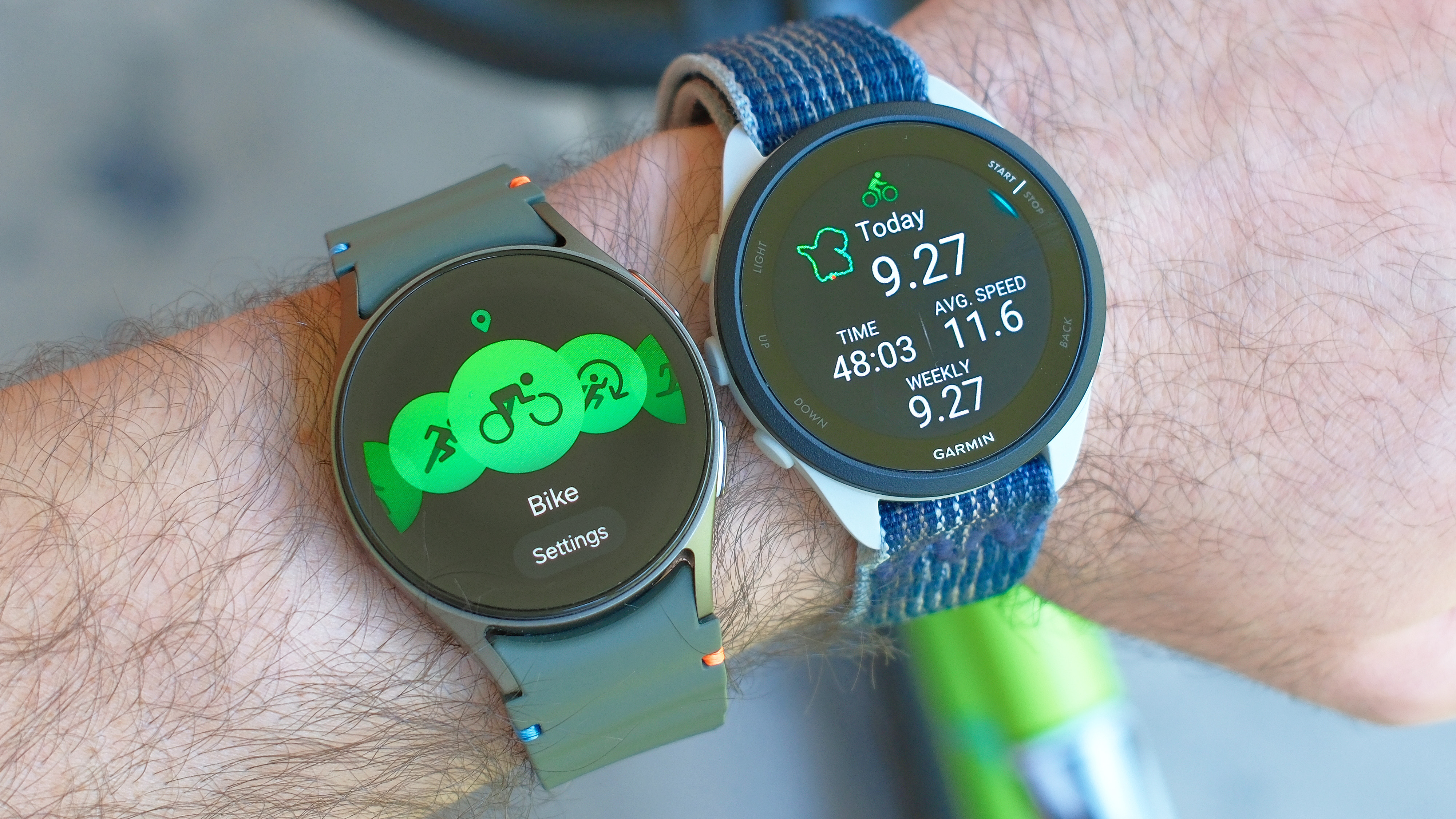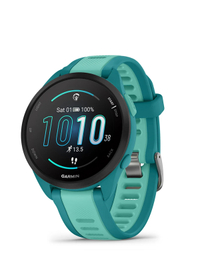I biked 9 miles with the Samsung Galaxy Watch 7 vs. Garmin Forerunner 165 — this one won
Which smartwatch is the cycling champ?

The Samsung Galaxy Watch 7 and Garmin Forerunner 165 are impressive mid-tier smartwatches boasting similar fitness tracking features and wellness tech. Both are also fresh for 2024 and cost about the same.
The Garmin is one of my favorite smartwatches to wear while hiking or biking — read our Forerunner 165 review — but it does have some faults, like slow-to-connect GPS. Once tracking, though, it's proven to be pretty darn accurate. Here's a look at the results from an 18-mile ride between the Forerunner 165 vs. Apple Watch SE. Hint: The Garmin wins.
So how does it stack up against the newly launched Samsung Galaxy Watch 7? Find out below.
Galaxy Watch 7 vs. Forerunner 165: price and features
Garmin Forerunner 165 Music: $299
As noted in our Forerunner 165 review, this is "a comfortable and lightweight GPS smartwatch sporting a bright AMOLED touchscreen, plenty of physical controls, solid battery life, accurate health sensors and advanced training tools." Plus, it supports contactless payments and this particular model has storage for music.
Samsung Galaxy Watch 7 40mm: $299
The Galaxy Watch 7 is one of Samsung's two shiny new smartwatches boasting tons of AI-backed wellness tech including improved sleep tracking, a daily Energy score, sleep apnea detection and more. By the way, the watch is still in its preorder phase but units should start shipping by the end of the month.
Before diving into our bike test, here's a quick breakdown of how these two watches compare. Price-wise, the Garmin is either $249 for the standard Forerunner 165 or $299 for the Music edition with built-in storage.
The Galaxy Watch 7 starts at $299 for the smaller 40mm model — which is the one I used for this test — and $329 for the 44mm. Add $50 for LTE connectivity.
Both devices sport bright and well-saturated AMOLED touchscreens; the Samsung's is a hair larger but the difference is negligible. Design and comfort-wise, the Watch 7 and Forerunner 165 are also remarkably similar.
For fitness tracking, onboard GPS comes standard on either model; however, the Galaxy Watch boasts a dual-band GPS antenna, whereas the Forerunner doesn't. This should, in theory, give the Samsung watch an advantage in urban or heavily wooded areas; my ride included both.
Sign up to get the BEST of Tom's Guide direct to your inbox.
Get instant access to breaking news, the hottest reviews, great deals and helpful tips.
You can monitor a wide range of workout types with either device and both track standard metrics like average and max heart rate, calories burned, distance covered, pace, speed and more. You also get lots of post-workout insights along with recovery and sleep-tracking features.
Galaxy Watch 7 vs. Forerunner 165: bike test

With a device on either wrist and Strava running on my iPhone (mounted to my bike), I set off on one of my two standard bike routes through central Seattle and some of the city's wooded areas.
Thanks to an early start, I was able to largely avoid commuter and foot traffic, which allowed me to maintain a fairly consistent speed throughout the duration of my ride.
Not only did I make my way in and around forested land and tall buildings, but the excursion involved a hefty amount of elevation gain, something not all devices do the greatest job accurately measuring.
Once safely back home and dripping with sweat, I synced the devices with their respective apps and dove into the data. Here's how it compares.
Galaxy Watch 7 vs. Forerunner 165: bike test results
| Header Cell - Column 0 | Galaxy Watch 7 | Forerunner 165 | Strava |
|---|---|---|---|
| Distance | 9.34 miles | 9.27 miles | 9.41 miles |
| Elevation gain | 556 feet | 577 feet | 534 feet |
| Average speed | 12.1 mph | 12 mph | 12 mph |
| Avg. pace | 4 mins 56 secs per mile | 5 mins per mile | 5 mins per mile |
| Avg. heart rate | 163 bpm | 164 bpm | n/a |
| Max heart rate | 193 bpm | 178 bpm | n/a |
| Calories burned | 522 calories | 498 calories | n/a |
When it comes to cycling, the two main data points I care about post-ride are distance covered and elevation gained. For distance, all three devices were within 0.14 miles of each other, which is encouraging.
I've biked this route dozens of times, almost always while tracking my stats on Strava or with some other fitness-tracking device. For this test, Strava recorded a 9.41-mile ride, just a little lower than the average for my past five attempts: 9.52 miles. Assuming Strava is accurate, both the Forerunner and the Galaxy Watch undercounted my total by marginal amounts, with the Garmin being slightly more off.

On the other hand, both wearables recorded more elevation gain than Strava which placed my climb at 534 feet; the average elevation gain for my past five rides on this route is 536 feet. While the Galaxy Watch is within 20 feet of that total, the Forerunner 165 overcounted by 41 feet, which is a somewhat significant amount. This outcome matches up with a previous test along the same route.
Back to the good news: Average speed and pace are a near match between all three devices. The Garmin and Samsung also noted similar average heart rates, however, the Galaxy Watch 7 recorded a sustainably higher max heart rate for my ride.
Though I thoroughly pumped the pedals on this attempt, my maximum recorded heart rate with any fitness tracker or smartwatch is rarely over 185 bpm. I'll have to do some more testing to find out if this recording is an outlier or the norm for the Galaxy Watch 7.
Galaxy Watch 7 vs. Forerunner 165: Galaxy Watch 7 wins
Based on distance and elevation accuracy, the Samsung Galaxy Watch 7 edges out the Garmin Forerunner 165 by the smallest amount to win this challenge. Both devices performed admirably, though. The Galaxy Watch's data just happened to be more aligned with our control and data from previous attempts on the same route.
The Galaxy Watch 7's GPS also connected nearly instantaneously when I started recording my ride; it took the Forerunner 165 more than 60 seconds to find a GPS signal and connect. That alone makes me more likely to wear the Samsung the next time I go for a two-wheeled spin around town.
More from Tom's Guide

Dan Bracaglia is the Tom’s Guide editorial lead for all things smartwatches, fitness trackers and outdoor gear. With 15 years of experience as a consumer technology journalist testing everything from Oura Rings to instant cameras, Dan is deeply passionate about helping readers save money and make informed purchasing decisions. In the past year alone, Dan has assessed major product releases from the likes of Apple, Garmin, Google, Samsung, Polar and many others.
An avid outdoor adventurer, Dan is based in the U.S. Pacific Northwest where he takes advantage of the beautiful surroundings every chance he gets. A lover of kayaking, hiking, swimming, biking, snowboarding and exploring, he also makes every effort to combine his day job with his passions. When not assessing the sleep tracking and heart rate accuracy of the latest tach gadgets, you can find him photographing Seattle’s vibrant underground music community.
-
TimmyB44 Good first review. Any chance you could do an overlay of the three routes that were tracked so we could see how they truly did against one another (and you could also point out areas where you knew you were here, not there)?Reply
Thanks! -
Bobtherobber Strava is definitely less accurate than devices meant for activity tracking. I have found that my galaxy watch 6 and my garmin edge bike computer are always way more accurate, especially around tall buildings than my phone with strava.Reply
If you want to find the true distance, strava web has a 'correct distance' and 'correct elevation' feature where it uses the data from its maps rather than what the device provided -
Averyfoto I'm calling the max heart rate a fluke because my 6 classic does it and so did my 3 classic. It usually happens when the watch isn't tight enough and I'm doing insane HIRT sessions. You'd think the software would see it as an oddity and filter it. The 3 was really bad about it. The 6 has done it maybe twice in a year. Also, if you have hair on your wrist, shave it!Reply


